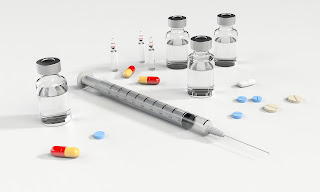Overview Of Intravenous (IV) Administration
Intravenous therapy (abbreviated as IV therapy) is a medical technique that delivers fluids, medications and nutrition directly into a person's vein. In fact, the term “intravenous” means “into the vein.” The IV route is the fastest way to deliver medications and fluid replacement throughout the body as they are introduced directly into the circulatory system and thus quickly distributed. Many therapies are administered as a "bolus" or one-time dose, but they may also be administered as an extended infusion or drip.
 |
| Intravenous injection |
Types Of Intravenous (IV) Injection
1. The simplest form of IV access is by passing a hollow needle through the skin directly into a vein. A syringe can be connected directly to this needle, which allows for a "bolus" dose to be administered.
Read Also:
Equipment
a. A syringe consists of a calibrated, cylindrical tube called a barrel and plunger or piston that fits tightly into the barrel. They are transparent and made of plastic or rubber.
b. Needle are tiny hollow metals that allow fine solution to flow through
c. Protective needle cover
2. Alternatively, the needle may be placed and then connected to a length of tubing, allowing for an infusion to be administered.
Equipment
a. Canula or scalp vein (butterfly)
b. Infusion giving set (needle and catheter)
c. Stand for infusion
Types of IV Therapy
a. IV Therapy for fluids
b. IV Therapy for blood transfusions
c. IV Therapy for medications
d. IV Therapy for nutrition
Standard IV Lines
Standard IV lines are typically used for short-term needs of about 4 days. With standard IV administration, a needle is usually inserted into a vein in your wrist, elbow, or the back of your hand. The catheter is then pushed over the needle. The needle is removed, and the catheter remains in your vein with an access cap.
A standard IV catheter is used for two kinds of IV medication administration:
IV Push/Bolus
An IV “push/bolus” is a rapid injection of medication. A syringe is inserted into your catheter to quickly send a one-time dose of a drug into your bloodstream.
IV Infusion
In IV infusion, the administration is controlled. There are two types. In Nigeria, the use of drip infusion is common. There is also pump infusion.
Drip Infusion
Drip infusion utilises gravity to send medication into the bloodstream.
Pump Infusion
Utilise pumps to regulate administration of medication. Very important when fine control of administration is required.
Central Venous Catheter (CVC)
central venous catheter (CVC) are for long term of.months. it is inserted into a vein in your neck, chest, arm, or groin area.
Read Also:
The three main types of CVCs include:
1. Peripherally inserted central catheter (PICC): A PICC is typically placed in a vein above your elbow in your upper arm. It sends medication from the area of insertion, through your veins, all the way to a vein near your heart.
2. Tunneled catheter: Tunneled catheter sends medication to veins.in the heart. One end of the catheter is placed into a vein in your neck or chest during a short surgical procedure. The rest of the catheter is tunneled through your body, with the other end coming out through your skin. Medications can then be given into that end of the catheter.
3. Implanted port: implanted port is located completely beneath the skin. To use this device, a healthcare professional injects medication through the skin into the port, which sends the medication into the bloodstream.

Comments
Post a Comment
Please have your say